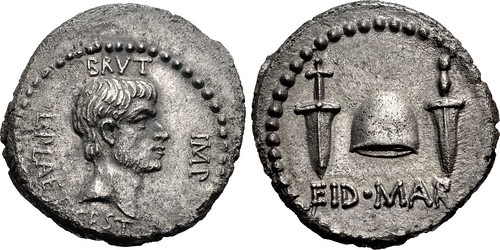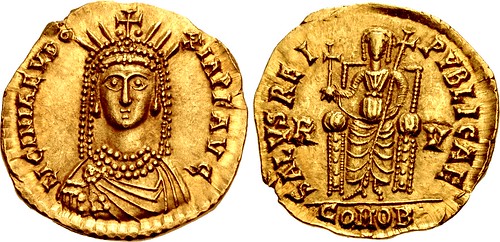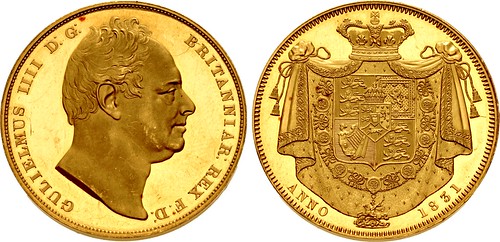
PREV ARTICLE
NEXT ARTICLE
FULL ISSUE
PREV FULL ISSUE
CLASSICAL NUMISMATIC GROUP TRITON XXIII SALEHere is the press release for Classical Numismatic Group's January NYINC sale, Triton XXIII. Some amazing coins here. -Editor Features Multiple Collections & Individual Rarities Classical Numismatic Group, LLC of Lancaster, Pennsylvania and London, England is proud to present Triton XXIII, a Public, Internet, and Mail Bid Sale to be held in conjunction with the 48th Annual New York International Numismatic Convention (NYINC) on January 14-15, 2020. The 2020 NYINC will be held at the Grand Hyatt Hotel, located at 109 East 42nd Street, New York, NY 10022, between Park and Lexington Avenues. Triton XXIII features 1453 lots of Greek, Celtic, Oriental Greek, Central Asian, Roman Republican & Imperatorial, and Roman Imperial coinage. Additionally, there are featured selections of Byzantine, Islamic, Indian and Related Coinage, Early Medieval, World, and British coinage and medals, as well as a nice selection of large lots. The pre-sale estimate total for Triton XXII is just over $7.5 million. Triton XXIII is highlighted by a number of collections and individual rarities, which make up the majority of coins on offer:
Lot viewing for Triton XXIII will begin on Sunday, January 12th, from 1PM until 7PM in the Broadway Room, located on the Conference Level (CC floor) of the Grand Hyatt Hotel. The complete lot-viewing schedule for Triton XXIII is: Sunday, January 12, 2020 – 1PM until 7PM;
Auction lots will also be available for viewing at the Pennsylvania offices of CNG from Monday, December 2nd, 2019 until Friday, December 27th, 2019 by appointment only. Please note that CNG's office hours will be limited during the holiday season. The auction sessions for Triton XXIII will be held in the Empire State Ballroom I, located on the Ballroom Level (B floor) of the Grand Hyatt Hotel. Triton XXIII will be conducted over four sessions with the morning sessions beginning promptly at 9:00 AM on Tuesday, January 14th, and Wednesday, January 15th, 2020, and the afternoon sessions will start at 2 PM on the same days. In addition, there will be an online, Internet-only, Session 5 for Triton XXIII, which CNG will be conducting as our Electronic Auction 460, and will open for bidding on January 8th, 2020. E-Sale 460 will feature over 1,000 lots, with a closing date of Wednesday, January 29th, 2020, and will include coins from some of the same collections listed above. Printed catalogs for Triton XXIII are now available. To order a catalog, please visit www.cngcoins.com. The catalog is $75 to North American addresses, and $100 to the rest of the world. Payment may be made by U.S. $ check or Visa/MasterCard. Catalogues have already been mailed to customers on CNG's active mailing list. CNG is currently accepting consignments for its next Feature Auction, CNG 114, scheduled for May 13th, 2020. The consignment deadline is Friday, January 31st, 2020. For further details and any additional information, please contact CNG, LLC at:Classical Numismatic Group, LLC
About the NYINC:
Just a few of the individual highlights from Triton XXIII are:  Lot 252–ATTICA, Athens. Circa 510-500/490 BC. AR Tetradrachm (26mm, 16.98 g, 9h). Head of Athena right, wearing crested Attic helmet decorated with small spiral on the bowl, and round earring / Owl standing right, head facing; olive sprig to left, ATE to right; all within incuse square. Seltman Group L (unlisted dies, but same hand as obv. dies A214–5); Svoronos, Monnaies, pl. 8, 8–13; HGC 4, 1589; Dewing –; Rhousopoulos 1945. Lightly toned, a few small cleaning marks on reverse. EF. Estimated at $20,000 From the Jonathan P. Rosen Collection. Ex Gemini XIII (6 April 2017), lot 41. Ex Sheikh Saud Al-Thani and JDL Collections  Lot 293–KINGS of PONTOS. Mithradates VI Eupator. Circa 120-63 BC. AR Tetradrachm (35.5mm, 16.62 g, 12h). Pergamon mint. Dated month 12, year 223 BE (September 74 BC). Diademed head right / Stag grazing left; BASI?EOS above, MITPA?ATOY/EY?ATOPOS in two lines below; to left, star-in-crescent above GKS (year); two monograms to right, IB (month) in exergue; all within Dionysiac wreath of ivy and fruit. Callataÿ p. 21, dies D55/R4, a (this coin, illustrated on pl. XI); HGC 7, 340; DCA 692; SNG BM Black Sea 1042; du Chastel 245; Leu 42, lot 269 (same dies). Virtually as struck, with a lovely old cabinet tone. Superb EF. Undoubtedly the finest specimen known. A spectacular portrait struck on an exceptionally broad flan. Estimated at $30,000 From the Jonathan P. Rosen Collection. Ex Classical Numismatic Review XLII.1 (Winter 2017), no. 436344; Sheikh Saud Al-Thani Collection (Numismatica Ars Classica 92, 23 May 2016), lot 185; JDL Collection (Numismatica Ars Classica 74 and Tradart 18 [joint sale], 18 November 2013), lot 289 (hammer 65,000 CHF); The Numismatic Auction II (12 December 1983), lot 122. Mithradates is the Hellenistic monarch par excellence, his career driven by megalomaniacal ambitions leading to murderous assaults upon family and followers and disastrous foreign adventures against superior forces. His idealized portraiture attempts to mimic the gods with its bold staring gaze and unruly, free-flowing hair, but at its most extreme is a personification of hysteria in its Dionysiac sense. The wreath of ivy on the reverse reinforces Mithradates' link with the god as well as making a connection with the cistaphoric coinage that circulated in the area. The stag probably represents the civic center of Ephesos and the mintmark is of Pergamon, all part of the new Pontic kingdom, symbolized by the star and crescent. His empire collapsed before the armies of Sulla and Lucullus, and Mithradates ended his own life in exile in the far region of the Crimea, pursued to the end by vengeful Romans and family.  Lot 620–The Republicans. Brutus. Late summer-autumn 42 BC. AR Denarius (18mm, 3.49 g, 12h). Military mint traveling with Brutus and Cassius in western Asia Minor or northern Greece; L. Plaetorius Cestianus, magistrate. Bare head of Brutus right; BRVT above, IMP to right, L • PLAET • CEST around to left / Pileus between two daggers pointing downward; EID • MAR below. Crawford 508/3; Cahn 20 (same dies); CRI 216; Sydenham 1301; RSC 15; BMCRR East 68-70; Kestner –; RBW –. Lightly toned, minor porosity. With NCG Photo Certificate 4936619-007, graded Ch AU, Strike: 5/5, Surface: 3/5. Very rare. The most famous of all Roman coins. Estimated at $200,000 From the Jonathan P. Rosen Collection. Ex Tklaec AG (8 September 2008), lot 188  Lot 775–Commodus. AD 177-192. Bimetallic Medallion (40mm, 69.15 g, 12h). Rome mint. Struck AD 191-192. L • AELIVS • AVRELIVS • COMMO DVS AVG PIVS FELIX, jugate heads of Commodus, radiate, and Amazon (Marcia or Roma), wearing crested helmet with visor, necklace, and pelta on chest / P M TR P XVII • IM P VIII C OS VII P • P, on left, Hercules, naked, right hand behind back, holding club draped with lion's skin set on stone; on right, Commodus, wearing sacerdotal dress, standing left, sacrificing with patera in right hand over lighted and garlanded altar and holding volumen in left. Gnecchi II, 116, pl. 85, 9 (same obv. die); Grueber 33, pl. XXXIV; Froehner p. 143; MIR 18, 1158-2/50; Cohen 2; Banti 4 (Commodus and Marcia); cf. Firenze 64. Green-brown patina, lightly chipped around edge. Near EF. Very rare. Estimated at $20,000 This remarkable obverse has been the cause of debate. The pelta, a distinctively Amazonian shield, has long led some to identify the female figure as Marcia, Commodus' concubine and trusted companion whom, we are told, the emperor loved to see dressed as an Amazon (SHA, Com. 12.1). The idea that Marcia – who was involved in the assassination of Commodus – should appear on a medallion of the emperor struck the year of his death has incredible historical and emotional appeal, and prominent 20th century scholars like Harold Mattingly and Jocelyn Toynbee accepted the identification. Others have discounted this fantastic claim, questioning the likelihood of a mistress with no official role or titles making an appearance on medallions. Dressel has argued that the pelta could be an attribute of Commodus rather than the female figure. "Amazonius" was one of the many titles the crazed emperor bestowed on himself late in his reign (when Commodus renamed the months of the year, March became "Amazonius"). A similar obverse type also from AD 192 has jugate busts of Commodus and a female figure wearing a helmet and cuirass, normally identified as Minerva. It is possible that the current obverse depicts Roma, as there is some evidence that Roma and Minerva were favored deities of the emperor.  Lot 906–Licinia Eudoxia. Augusta, circa AD 439-490. AV Solidus (20mm, 4.48 g, 5h). Commemorative issue. Ravenna mint. Struck circa AD 439 or 444-445. LICINIA EVDO XIA P F AVG, facing draped bust wearing radiate crown with central cross and elaborate pearl diadem, and pearl necklace of three strands / SALVS REI PVBLICAE, empress enthroned facing, holding globus cruciger in her right hand and long cruciform scepter with her left; R-V//COMOB. RIC X 2023; Depeyrot 16/2; Ranieri 117-8; Biaggi 2356; DOCLR 870. Lightly toned. Superb EF. One of the finest known. Estimated at $100,000 From the Provence Collection. Ex Palombo 17 (20 October 2018), lot 117 Licinia Eudoxia was the only surviving child of the Eastern Roman Emperor Theodosius II, and in 424 AD, at the age of two, was betrothed to her four-year-old cousin, the future Emperor of the Western Roman Empire Valentinian III, in order to reunify the two halves of the Roman world. Their marriage produced two daughters, but was abruptly terminated when Valentinian was killed by two Scythians, Optelas and Thraustelas, at the behest of the usurper Petronius Maximus. After buying off the military and palace officials, Maximus cemented his claim to the throne by forcibly marrying Eudoxia only a few days after her husband's murder. At least one historian theorized that Maximus' marriage to Eudoxia was motivated by revenge against the late Valentinian in return for the Emperor's rape of Maximus' first wife. Maximus also married his son Palladius to Eudoxia and Valentinian's daughter Eudocia, thereby severing her engagement to Huneric, the son of the Vandal king Gaiseric. Deeply unhappy, Eudoxia somehow managed to contact Gaiseric to beseech him to depose Maximus. The Vandals successfully besieged Rome and carried Eudoxia off to Carthage, along with her daughters; Maximus was assassinated by members of the Imperial household during the siege and his body thrown into the Tiber. In 462 AD, after seven years in Carthage, Eudoxia and her daughter Placidia were ransomed by Leo I and moved to Constantinople, while Eudocia remained in Carthage and married Huneric as her parents had originally intended. The rest of Eudoxia's life passed unrecorded; even her exact date of death is unknown. Struck at Lucca After the Defeat of Desiderius in 774  Lot 1025–CAROLINGIANS. Charlemagne (Charles the Great). As Charles I, King of the Franks, 768-814. AV Tremissis (18mm, 1.00 g, 12h). Lucca mint. Struck after the defeat of Desiderius in 774. + FL (star) A VI • A (star) LVC (star) A •, six-rayed star; small leaves between rays; pellet in Vs and C / D • N CAR VLVS R?X, facing half-length bust. Cf. Grierson, Coins of Medieval Europe, p. 31; Rossini 3; Bernareggi –; Bernareggi, Tremissi –; Bernareggi, Moneta, –; Depeyrot 515B = CNI IX 1 = Gariel 172 = Kluge 199; BMC Vandals –; Arslan –; MEC 1, –; E&S p. 213. A coin of great historical and iconographic interest. Areas of light toning, trace of lamination, a couple of hairline flan cracks. EF. Extremely rare. Estimated at $100,000 From the Richard A. Jourdan Collection of Medieval European Coins. Ex CNG Inventory 520231. The only gold coin to bear a portrait of Charlemagne, one of the most important figures in world history. His deeds shape Europe to this day. Following Charlemagne's conquest of the Lombardic kingdom in 774 AD, a short-lived issue of gold tremisses was struck at a range of mints across northern Italy in his name. These rare coins are all of the same star/cross potent type of the defeated Desiderius, except for an extremely rare issue at Lucca that remarkably depicts the King of the Franks on the reverse. Rossini records only six specimens of the portrait issue, four of which are damaged and incomplete. Only one other example has previously appeared at auction. That coin, from the Adams collection (Triton XIX, lot 2207), realized $180,000 in 2016. From the Murdoch and Copp Collections  Lot 1346–HANOVER. William IV. 1830-1837. Pattern AV Five Pounds (38mm, 39.87 g, 5h). London mint. Dated 1831. GULLIELMUS IIII D : G : BRITANNIAR : REX F : D :, bare head right / Coat-of-arms within Order of the Garter, crowned and mantled; ANNO 1831 below. L&S 2; ESC 272; Montagu 1086; W&R 270 (this coin cited); SCBC 3833. In NGC encapsulation 4747472-001, graded PF 62 Ultra Cameo. A magnificent coin. Attractively toned with a deep cameo finish. Extremely rare. Estimated at $200,000 From the G.W.K. Roberts Collection. Ex Schweizerischer Bankverein 4 (17 October 1978), lot 260; J. G. Murdoch Collection (Part III, Sotheby, Wilkinson, & Hodge, 15 March 1904), lot 437; A. E. Copp Collection, sold privately in 1887. Struck to the exact weight of five Sovereigns from the dies used for the proof Crown of 1831, this pattern Five Pounds of William IV is one of the great rarities of the British series. For any collector attempting to form a complete collection of Five Guinea and Five Pound pieces by monarch, from Charles II to Elizabeth II, the Five Pounds of William IV is by far the most challenging coin to obtain. The specimen offered here is in superb condition and has not been on the market for over 40 years. It once graced the celebrated cabinet of John Gloag Murdoch, one of the finest collections of British coins ever assembled. Murdoch acquired the coin in 1887 from Alfred Evelyn Copp, the Treasurer of the Numismatic Society of London and distinguished collector of rarities.  Wayne Homren, Editor The Numismatic Bibliomania Society is a non-profit organization promoting numismatic literature. See our web site at coinbooks.org. To submit items for publication in The E-Sylum, write to the Editor at this address: whomren@gmail.com To subscribe go to: https://my.binhost.com/lists/listinfo/esylum All Rights Reserved. NBS Home Page Contact the NBS webmaster 
|